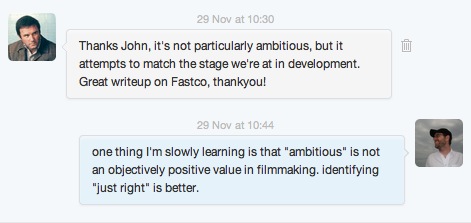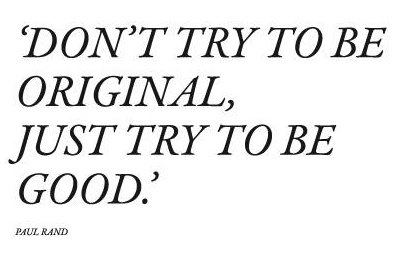January 31, 2012
A thing to practice: quiet, low-concept filmmaking
I openly idolize Charles and Ray Eames’s filmmaking, especially the elegant, playfully “high concept” explainers they made like Powers of Ten. I also idolize the technically innovative, brimming-with-process-value “brand journalism” that Google produces in its promotional videos. When I saw this spot, I didn’t just love it. I lusted it:
It’s the kind of filmmaking that I wish I could do all the time, on every project: physical, inventive, unconstrained by petty things like “time” and “budget”, and engaging as hell.
The closest I’ve gotten—and it’s pretty darn close—is the “Lego Antikythera” film I directed last year, which had a large budget (relatively speaking, compared to what I’d worked with before) and got nearly 2 million views on Youtube, Vimeo, and elsewhere:
Since making that film, I’ve been lucky to parlay its success into working with generally bigger budgets and more “high concept” projects. Just what I wanted, right?
Well… Those kinds of films, while creatively invigorating, can also be kind of exhausting to produce—or even get to produce. The bar is set pretty high each time and the energy barrier for client “buy-in” is high, too. And even when the budgets swell, it still “never feels like quite enough.” The high-concept reach always wants to extend just a few inches beyond one’s practical means, no matter what the scale is. (Maybe this just means I’m a bad producer.)
Moreover, I’m noticing more and more that I am just as inspired and engaged by quiet, simple, “low concept” films. Like this promo for Twitter’s redesign…
Or this concept/demo video for BERG’s Little Printer:
Or this wonderfully elegant, tactile documentary about letterpress:
Or this concise, stylish, informative portrait of the inventor of the first digital camera:
In a sense, these films all look and feel “the same.” A lot of locked-off shallow-focus shots composed like still photographs, lined up in a stately pace, with some cute or elegant or simply unobtrusive music underneath. There’s not a lot of formal inventiveness or physical “wow factor” like the Google videos or Eames films. And yet, they connect.
I want to train my creative brain to consider this kind of filmmaking more often, but it takes effort. There’s a fear there: how can I get anyone to pay me decently to make something that looks this… easy? How will anyone notice me (and want to hire me) if what I make is this… simple? If I don’t shoot for the moon every time out, turn every project into some kind of ambitious experiment (for better or worse), aren’t I… settling?

Above is a Twitter conversation I had with Timo Arnall, a “director, designer and researcher” at BERG and the filmmaker behind that Little Printer clip (as well as all of BERG’s other great video work). I had a sense that I might be drifting from my own creative maxim, borrowed from Paul Rand: “Don’t try to be original. Just try to be good.”

What I love about Arnall’s work is that it’s all about “just trying to be good.” Good in the sense of effective and useful. It’s well-designed, suited to its task, and not tricked up any more than that. (It exemplifies another maxim I like to remind myself of, by Milton Glaser: “Less is not more. Just enough is more.”)
It’s not surprising because at BERG, filmmaking is a means—a tool for illuminating and exploring design ideas—not an end in itself, or at least not an end in the way I usually think of it.
The irony is that the mighty Eameses also made quiet, low concept films—they’re not as well known as, say, “Powers of Ten”, but they’re just as bewitching. Toccata for Toy Trains or Blacktop: A Story of the Washing of a School Play Yard wouldn’t look out of place on Vimeo’s DSLR page, even though they were made half a century ago.
Another irony is that making something that appears simple or “just enough” is often much more challenging than “shooting for the moon.” I think it requires more creative confidence—the confidence not only to achieve “just enough,” but to even recognize it. “Just enough” is a point, not a space or a range. And its location is not always obvious. Throwing a ball over a high wall is one thing, but throwing a ball to knock a pebble off the wall is quite another.
Keith “keef” Erlich, a talented director who recently launched a small business built around this kind of “just enough” filmmaking, coined a phrase I quite like recently while we were chatting over coffee: “middle-class media making.” Basically, the idea of doing good creative work in a sustainable way for decent pay, in a zone somewhere between being a young’n’hungry striver and being a creative”1 percenter” like Mark Romanek or Spike Jonze. Or to use another analogy: “middle class media making” is like owning a successful small restaurant in a neighborhood you like—rather than being a dishwasher, or being David Chang.
As someone who recently started a family, that sounds like winning to me. Could doing more of this “quiet” kind of filmmaking be a way of helping myself build a more sustainable “middle-class media making” career? I wonder.
I’m proud of the fact that every film I’ve made in the past couple years is very different from every other. That was on purpose. In a way, doing more “low concept” projects would continue that trend. At the very least, it’s probably something worth experimenting with—if only to confront some fears, and avoid falling into a rut.